
HUGE FUNGI GROWTH
IN SOUTH POLAR REGION
Report #021
June 29, 2001
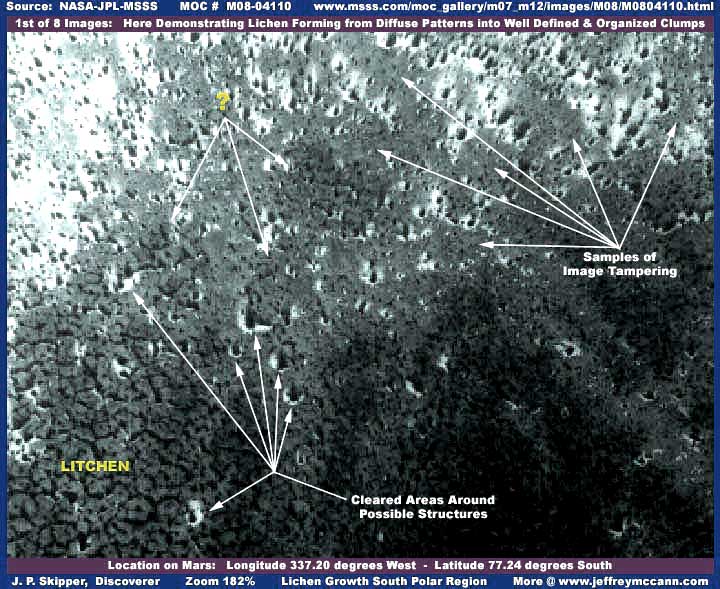
The above first of eight images here shows part of a high ground table land covered by what appears to be a large area of huge size fungi-lichen-alga-mold growth. The upper levels of this strip (not shown) shows large numbers of dark water stains and some areas of possible dark low fungi-lichen growth. But it is this high ground table land seen here in my images, that the lower level terrain builds up to, where this huge size lichen-fungi growth I'm reporting is prominent. This field of huge size fungi growth in this high ground extends down this very long original strip for a ways before falling back via canyons and ravines into lower level terrain again. The higher ground of this table land and the tops of the sharp high ridges formed by the canyons and ravines is where this huge lichen-fungi field flourishes and I have tried to capture most of this section of the original strip in the images here.
The above top image here moving down the strip demonstrates the beginnings of the huge fungi field of growth in the strip and its transition from a diffuse colony pattern in the lower right side areas of the image to the beginnings of well defined and organized huge size clumps in the lower left corner. Many of the smaller dark spots scattered over the upper areas are water stains evidencing the presence of moisture that is enabling and fueling the lichen-fungi-alga-mold growth you see here. The yellow upper question mark labeling and arrows in this image point to groups of objects that have received some object specific image tampering causing them to fuzz out and be unidentifiable. The lower group of arrows point to samples of indistinct objects at the edge of resolution with circular cleared areas around them. The lighter colored diffuse patches seen all over the middle and upper levels of this image, with samples pointed out in the upper right group of arrows, is a flattened fog image tampering designed to mimic the appearance of diffuse looking fungi growth. Good enough to avoid detection by those who do not really want to know but not good enough to get past a reasonably objective examination.
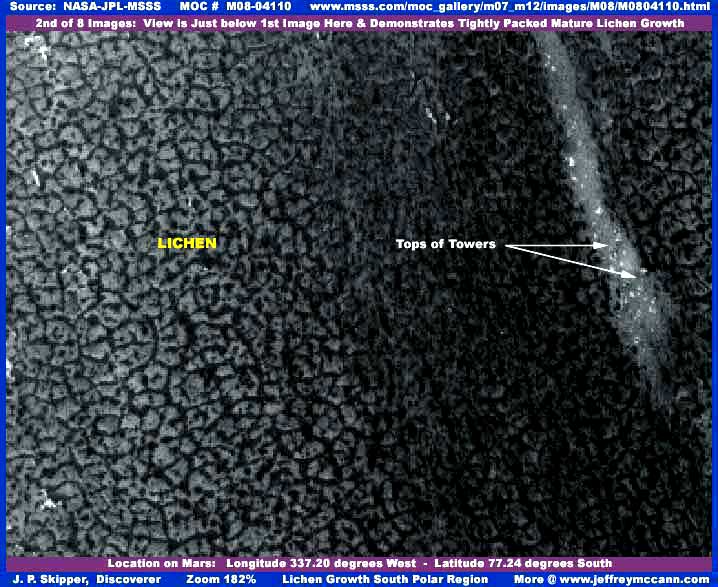
The above second image was taken scrolling down immediately under the first top image here. It shows how the lichen coverage is now in tightly packed well defined colony clumps and so dense as to not allow any view of the ground surface underneath at all. The narrow dark inter-spaces between clumps that sort of look like cracks are open spaces outlined in shadow necessary to allow ventilation around each colony clump and the often irregular folded appearance of many clumps serves essentially the same purpose in allowing ventilation into the center areas of each clump. The long narrow light colored band you see angling from top to near bottom in the right side of the image is, in my opinion, fog image tampering covering what appears to be buildings. If you look very close where I have pointed with two arrows, you can see what appears to be the top of two tiny towers sticking out of the tampering treatment. The size of these tower structures should give you a better idea of just how enormous each of these many individual lichen-fungi clumps really are.
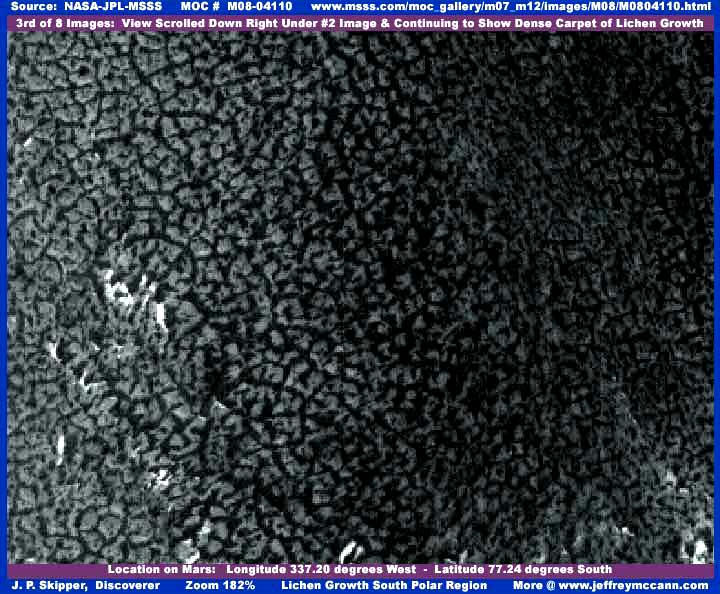
The above third image provides a view taken immediately under the 2nd image above. As you can see, this lichen-fungi-alga-mold growth field continues in a solid carpet of well defined and organized colony clumps so dense that still no ground surface is visible. This doesn't tell us to much since the carpet of growth is so complete that there is literally nothing much else recognizable to compare it to in this view. By the way, you should know that the view in all my images here is almost from one side edge of the original image strip to the other with very little loss of information. No telling how far off to the left or right of the original image strip view of this high terrain table land area this lichen field extends over.
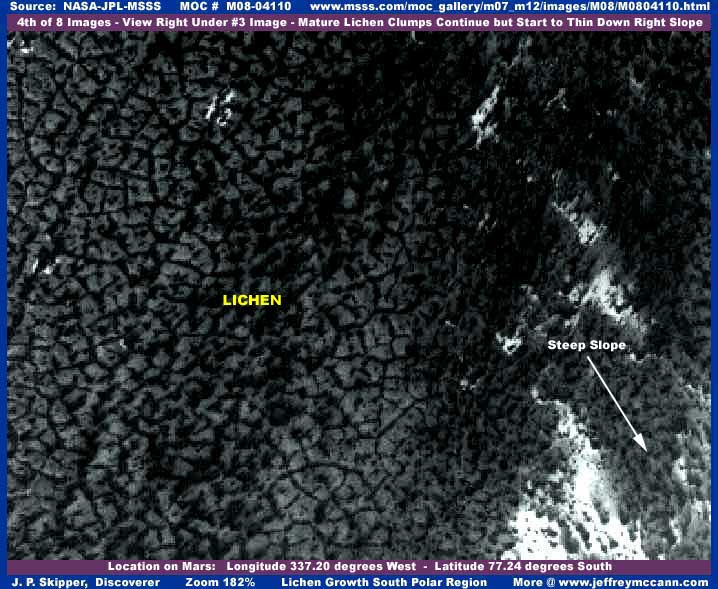
This above fourth image is a view taken immediately under the third image. The big lichen growth field continues in a solid carpet of well defined clumps as in the previous two images but now the beginnings of a steep slope can be seen on the right as we enter the general area where this table land starts breaking up into canyons and ravines and starts dropping back down to lower level terrain. On the steep slope area, the lichen is beginning to thin out and more ground terrain begins to be seen to put things in perspective a little more.
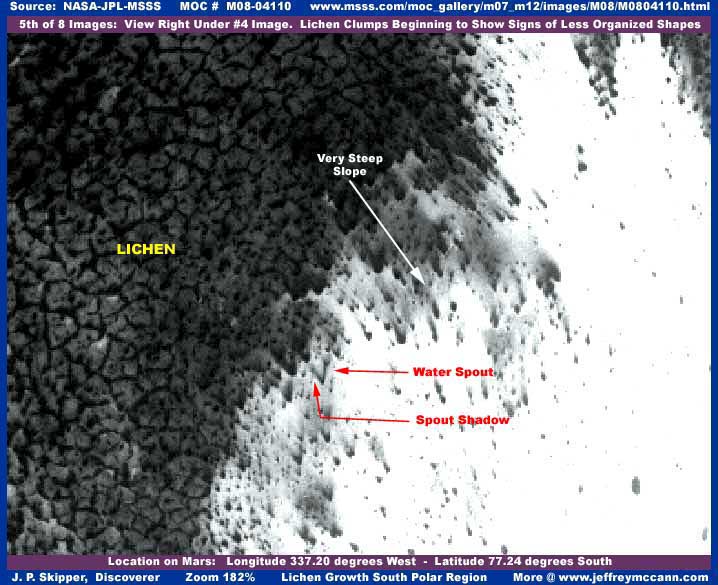
In the above fifth image taken right under the fourth image above, the well defined fungi-lichen growth clumps still continue in a solid carpet right down to the image bottom on the left. However, right down at the very bottom edge of my image in the left corner there is just the beginning tip of a less well defined and/or organized appearing fungi growth characterized by a roundish billowing shape. This type of possibly different lichen-fungi growth will dominate and be better seen in the images below as we leave this tight compact dense well defined and organized growth behind. This may be younger less well defined and organized same species growth or a perhaps different type of fungi growth entirely with a different shape adaptation in its mature form. Also, now the steep slope on the right is much more revealed with dark water stains and probably exposed rocks on it. Note that the lichen does not appear to want to grow down this slope in spite of the water presence.
I've also pointed out with red arrows what appears to be a water spout or plume, complete with a tapered to ground base column and broadening head at top consistent with water spout appearance, standing alone and throwing a shadow up the steep slope behind it. To see most of the anomaly evidence on Mars, you have to think small and it is rare to have big anomaly evidence sticking right in your face like these huge size fungi growth. That water spout shadow is short because of the steep slope going up behind the spout and would normally be a much longer shadow in flatter terrain. Note that the sun angle is not very low overhead as the depths of the canyons are not in shadow and have full light in them. This may be a natural geological water spout but it may also very well be as a result of interaction between the fungi spores and water below the snow surface in a reproductive cycle blasting spores into the air via a melt water based pressure build up mechanism. The spore presence in the water may also contribute to an explanation as to why the water stains are so dark other than just because of beginning fungi growth on the snow surface and contrast with the white snow color. Remember, this is a different world from Earth and life adaptations are going to be different in acclimating to unique Mars survival conditions even though other features and factors will at the same time be somewhat familiar to us.
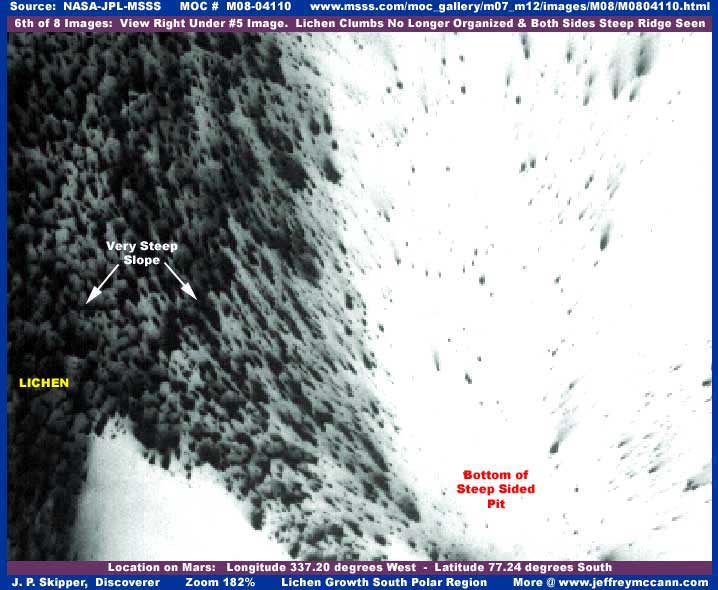
In the above sixth image view taken right under the fifth image above, we can now clearly see that this is a sharp top narrow ridge curving off to the right and that the now different appearing lichen-fungi growth appears to prefer the very top of the ridge where it seems to flourish best. It seems able to grow down the steep slope for a limited distance but doesn't seem to want to or do very well at it and seems to prefer the left to the right slope in the locale above. This is probably a function of sunlight not penetrating (even though it does here in these views) very well into the depths down the steep slopes in sufficiently long enough duration for this life form. Just as important is which areas of the ridges gets the most sunlight. The lichen no doubt needs the sunlight for its processes but probably just as important in this cold environment is sunlight warmth on the terrain and possible snow melt water which is going to be more favorable the higher up the ridge you go and best right on top because of prolonged sunlight exposure. The bottom of the hole you see above on the right may not only not get sufficiently long enough sunlight and it may well be critically colder than at the top of the slope as far as this life form's survival is concerned.
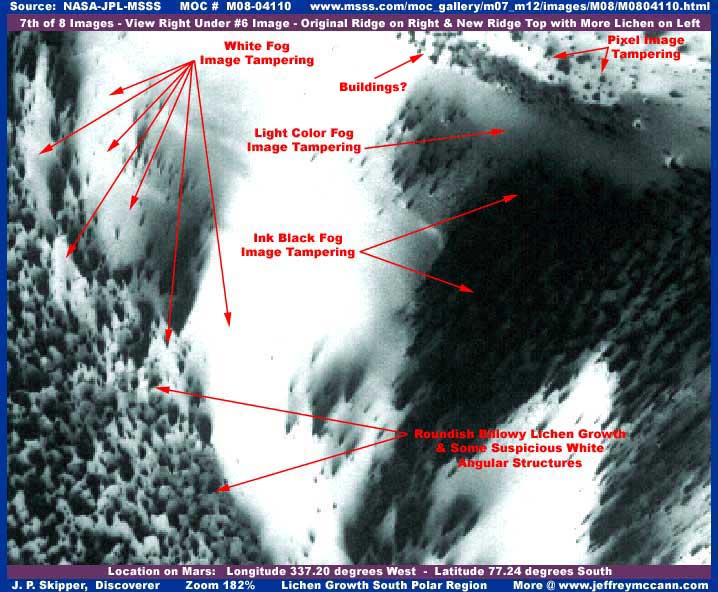
In the seventh image above taken right under my sixth image, the ridge with the well defined and organized lichen growth previously seen in the first images here has veered off to the right and we can now see little of it other than its steep left slope and a piece of the top ridge edge. Then there is a deep canyon and now the edge of a second ridge on the left with more of the roundish billowy fungi-lichen shapes coming into view. Unfortunately, here I am again having to report on rather extensive image tampering in this particular view and some possible civilization evidence as evidenced in the above image labeling and arrows. I have said it many times and will say it again, even though none of the "experts" want to hear or deal with it, where there is water on Mars, there is usually civilization evidence where conditions will allow it. This fact makes it difficult for who ever has taken it upon themselves to decide that water and vegetation evidence is ultimately acceptable (since it has not been covered up) for eventual discovery and view by us but the civilization evidence usually always clustered around the water is not acceptable and must be covered up. Don't you just love it when someone makes all these decisions for you and you have nothing to say about it even though it is your money that has paid for all "this."
Note that the whole white center from vertical top to bottom at first glance appears to be just a side of the slope but on closer examination is actually a big mass of white fog tampering application designed to mimic the slope. The pixel image tampering I have labeled in the upper right corner of this image can hardly be seen in my above image but it is there and takes the form of a horizontal rows of highly enlarged pixels (reduces resolution in that spot) tracking along the edge of the ridge top. Likewise the ink black fog image tampering on the right slope can not be seen very well in my image because the contrast was optimized for the fungi-lichen growth detail on the left ridge. But, when I play around with the colorization and contrast and lightening of this image, the not natural inky black tampering is clearly evident. That's the problem with this kind of reporting, it would take at least 15+ images to properly report everything. As it is, eight images out of a single strip is a record high number for me.
As I've said before, I would have preferred not to have to bring this type of evidence up but it is there and I am compelled to report it. I believe that the discovery of this fungi-lichen life form is very important to the ultimate beginning realization as to what is and is not possible on Mars by scientists. I believe that my inclusion of reporting of this image tampering and relatively small, minor, and ambiguous (because of its small size & being at the limit of resolution) civilization evidence will detract from scientific focus on this discovery. Because the large majority of scientists are simply unable to admit the civilization and image tampering evidence can exist, they will no doubt ignore and dismiss the natural life discoveries along with what they believe (or at least prefer to believe) is completely impossible. What a shame, judgment without full objective investigation equals blindness! It is also why they can not make these discoveries for themselves.
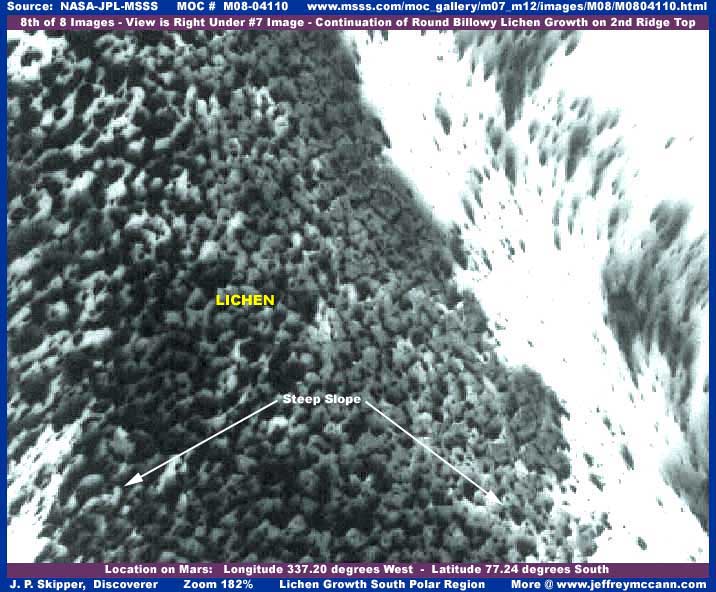
In the above Eighth and last image taken right under the seventh image, we are now fully on the second ridge with nothing much of the original first ridge seen. Here the lichen-fungi growth is pretty large and thick on the new second ridge top but shows little tendency to form the tightly packed flatten top well defined and organized super dense clumps seen in the first images here. Maybe it is not old enough or advanced enough in its development to reach this stage or maybe it is a different type fungi growth and this is its permanent and different adaptation mature form? From this point on down the strip (not shown) there is just a little more of what you see here but thinning out quickly down to just basically water stains, flattened diffuse form fungi growth, and rocks. No more of the high ridge tops are seen in the rest of the original strip below this point, only sides and slopes and lower terrain which no doubt explains why the lichen-fungi growth thins out so in these areas just as it does deeper down the steep slopes seen here.
In the lower areas below this point not shown here, there also seems to be evidence of very strong prevailing high winds that has sort of flattened and elongated the fungi-lichen growth, scoured and exposed rocks, and also effected the direction of the water stains. Yet, this is not the case on the table land and ridges seen in the images here or even further down at the bottom of the strip. I speculate that the high terrain area with the flourishing fungi growth seen in the images here may be in a protected pocket by nearby even higher terrain or, conversely, that higher nearby terrain has channeled and squeezed winds over this particular section of terrain like the blast from a directional fan. Too bad these narrow strips limit our view so much.
DOCUMENTATION
http://www.msss.com/moc_gallery/m07_m12/images/M08/M0804110.html: This report's images are taken from the NASA/JPL/MSSS official M08-04110 original image strip. Please note that the Malin front page image does not work, the first listed medium quality jpeg strip does not work, and the second listed best quality gif strip does not work. Only the third listed not-map projected gif strip works and I took my data from that. I did not try the fourth or fifth listed PDS format strips and can not say about them. Since there is no context image to compare it to, I can not say whether the third listed gif strip has been flipped or not as is sometimes the case with Malin third listed strips. I took it and my data from it as it was presented by Malin. Also, I have not accessed this image strip at PDS or USGS and can not offer any comments as to what may or may not be there. Good Luck!
, Discoverer
![]()